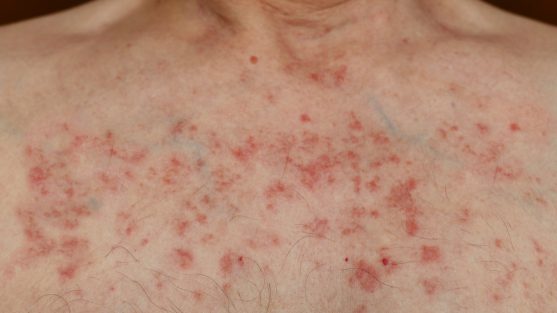Skin changes are quite common among cancer patients undergoing chemotherapy. In most cases, the skin changes are not severe, but can be noticeable and uncomfortable. This reminds the patients of their cancer battle and affects their mental health.
Sometimes, these changes in the skin can affect the treatment plan and be detrimental to the patient’s quality of life. However, the good news is that most skin changes are manageable and reversible after completion of treatment.
Chemotherapy focuses on one feature of the cancer cells – they divide at a faster rate than the normal cells. Thus, the drugs target the fast-growing cancer cells. This is the basic principle for many chemotherapy agents.
However, this mechanism of action can affect the normal fast-growing cells of the body, such as the skin, hair follicles and cells lining the digestive tract. This results in side effects such as changes in the skin, hair loss, and diarrhea and other gastrointestinal problems.
There are several skin changes that occur as a side effect of chemotherapy. The side effect depends on the drugs administered. The most common ones are discussed below.
A skin rash is a common side effect of chemotherapy. It can appear on the face, scalp, neck, upper back, chest, and other parts of the body. These rashes can be itchy, painful or lead to a burning sensation.


Some of the common drugs that can cause skin rash include, taxanes such as paclitaxel and docetaxel, gemcitabine, oxaliplatin and bleomycin.
Here are some things you can do to reduce your rashes:
Moisturising can ease rashes
Most chemotherapy drugs are administered via intravenous infusions. Occasionally, the drug may accidentally leak outside the vein, into the surrounding tissues. This is known as chemotherapy extravasation.
This can cause pain and burning sensation. If left untreated, it may result in an open wound. Based on the type of drug infused, this can cause serious complications in patients.
However, quick detection of extravasation and treatment can reduce the tissue damage.
These steps are taken to reduce the tissue damage:
Most extravasation incidences can be prevented with careful monitoring by the health care team, including regular inspection of the intravenous access site, flushing the access before and after the infusion, and patient monitoring during the infusion.
If you develop hand and foot syndrome, the skin on the palms and soles of your feet may become red, sore, and may peel (desquamation).
Other symptoms include:
Hand and foot syndrome may make simple tasks difficult and affect your quality of life.
Some drugs that are more likely to cause hand and foot syndrome include docetaxel, paclitaxel, cytarabine, capecitabine, doxorubicin, floxuridine, fluorouracil, idarubicin, liposomal doxorubicin, vemurafenib, etc.
Given below are some tips and instructions that can help you relieve the symptoms and manage hand and foot syndrome:
Ice packs can ease symptoms
Dry skin can be rough, red, flaky, may have cracks in the skin, and at times painful.
Prolonged itching may lead to breaking of the skin, bleeding, or infection.
The following tips may help manage dry and itchy skin:
Drinking water can reduce itchy skin
Hyperpigmentation means darkening of the skin. This can occur over a small region or at one particular spot.
It usually occurs within two to three weeks of initiation of chemotherapy and resolves 10 to 12 weeks after stopping treatment.
Drugs such as cyclophosphamide, 5-fluorouracil, methotrexate and busulfan, have shown to cause hyperpigmentation.
Photosensitivity, or sensitivity to light, can also be a side effect of chemotherapy.
One of the chemotherapy drugs that causes sensitivity to light is 5-fluorouracil.
Given below are some tips to treat and prevent photosensitivity caused by chemotherapy:
The skin changes mentioned above may or may not occur in all patients undergoing chemotherapy.
While the home care measures listed in this article may help you manage your skin changes, it is always advisable to consult your doctor before implementing any of these measures.
Moreover, your doctor may recommend some further tips and guidelines to manage your specific skin problems.
కీమోథెరపీ కోసం క్యాన్సర్ రోగులు ఎలాంటి దుస్తులు ధరించాలో తెలుసా? ఈ ఆర్టికల్లో, క్యాన్సర్ రోగులకు కీమోథెరపీని సౌకర్యవంతంగా పొందడంలో సహాయపడే దుస్తుల జాబితాను అందించాము.
ఈ కథనం మీ క్యాన్సర్ రకానికి సరైన క్యాన్సర్ వైద్యుడిని కనుగొనడానికి 6-దశల గైడ్ను వివరిస్తుంది.
तंबाकू का सेवन गुटका, जर्दा, पैन मसाला आदि के रूप में करना सिर और गले के कैंसर का मुख्य कारण…
నోటి పుండ్లతో బాధపడుతున్న క్యాన్సర్ రోగులకు క్యాన్సర్ చికిత్సలో ఉన్నప్పుడు తీసుకోవాల్సిన 12 ఉత్తమ ఆహారాలు.
క్యాన్సర్కు కారణమయ్యే 6 జీవనశైలి కారకాలు గురించి ఈ కథనంలో వివరంగా ఇవ్వబడ్డాయి. అవి ఏమిటో తెలుసుకోండి!
शोध की मानें तो न्यूज़पेपर प्रिंट करने में जो स्याही का इस्तेमाल होता है उसमें ऐसे केमिकल होते हैं जो…